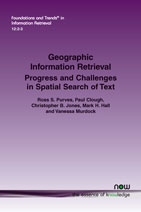Geographic Information Retrieval: Progress and Challenges in Spatial Search of Text
By Ross S. Purves, University of Zurich, Switzerland, ross.purves@geo.uzh.ch | Paul Clough, University of Sheffield, UK, p.d.clough@sheffield.ac.uk | Christopher B. Jones, Cardiff University, UK, JonesCB2@cardiff.ac.uk | Mark H. Hall, Martin Luther University Halle-Wittenberg, Germany, mark.hall@informatik.uni-halle.de | Vanessa Murdock, Microsoft, USA, vanmur@microsoft.com
Abstract
Significant amounts of information available today contain references to places on earth. Traditionally such information has been held as structured data and was the concern of Geographic Information Systems (GIS). However, increasing amounts of data in the form of unstructured text are available for indexing and retrieval that also contain spatial references. This monograph describes the field of Geographic Information Retrieval (GIR) that seeks to develop spatially-aware search systems and support user’s geographical information needs. Important concepts with respect to storing, querying and analysing geographical information in computers are introduced, before user needs and interaction in the context of GIR are explored. The task of associating documents with coordinates, prior to their indexing and ranking forms the core of any GIR system, and different approaches and their implications are discussed. Evaluating the resulting systems and their components, and different paradigms for doing so continue to be an important area of research in GIR and are illustrated through a number of examples. The article concludes by setting out a range of future challenges for research in this field.
Geographic Information Retrieval: Progress and Challenges in Spatial Search of Text
Significant amounts of information available today contain references to places on earth. Traditionally such information has been held as structured data and was the concern of Geographic Information Systems (GIS). However, increasing amounts of data in the form of unstructured text are available for indexing and retrieval that also contain spatial references. This monograph describes the field of Geographic Information Retrieval (GIR) that seeks to develop spatially-aware search systems and support user’s geographical information needs. Important concepts with respect to storing, querying and analysing geographical information in computers are introduced, before user needs and interaction in the context of GIR are explored. The task of associating documents with coordinates, prior to their indexing and ranking forms the core of any GIR system, and different approaches and their implications are discussed. Evaluating the resulting systems and their components, and different paradigms for doing so continue to be an important area of research in GIR and are illustrated through several examples.
The monograph provides an overview of the research field, and in so doing identifies key remaining research challenges in GIR.
